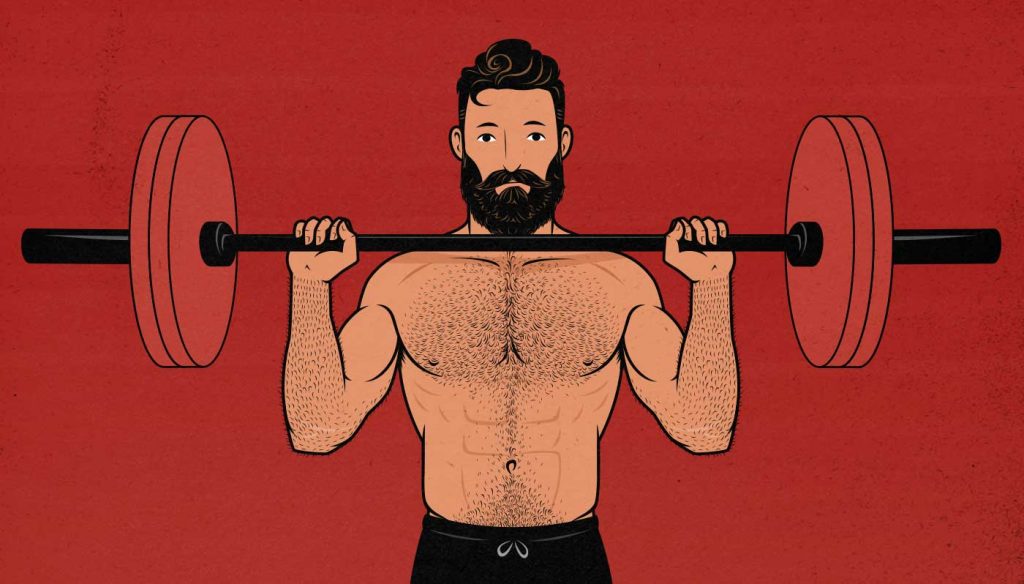
The Overhead Press Hypertrophy Guide
The overhead press (often referred to as the military press) is the best lift for bulking up our shoulders. It’s also fantastic for our upper traps, upper chest, triceps, posture, and even our abs, making it one of the best lifts for building a bigger shoulder girdle, developing general strength, and improving our aesthetics. And, of course, as you may have already guessed, pressing is the opposite of depressing. As a result, we consider it one of the five main muscle-building lifts.
In this article, we’ll go over how to program the overhead press into your workout routine, how to min-max your technique for even more muscle growth, and how to choose the best assistance and accessory lifts.
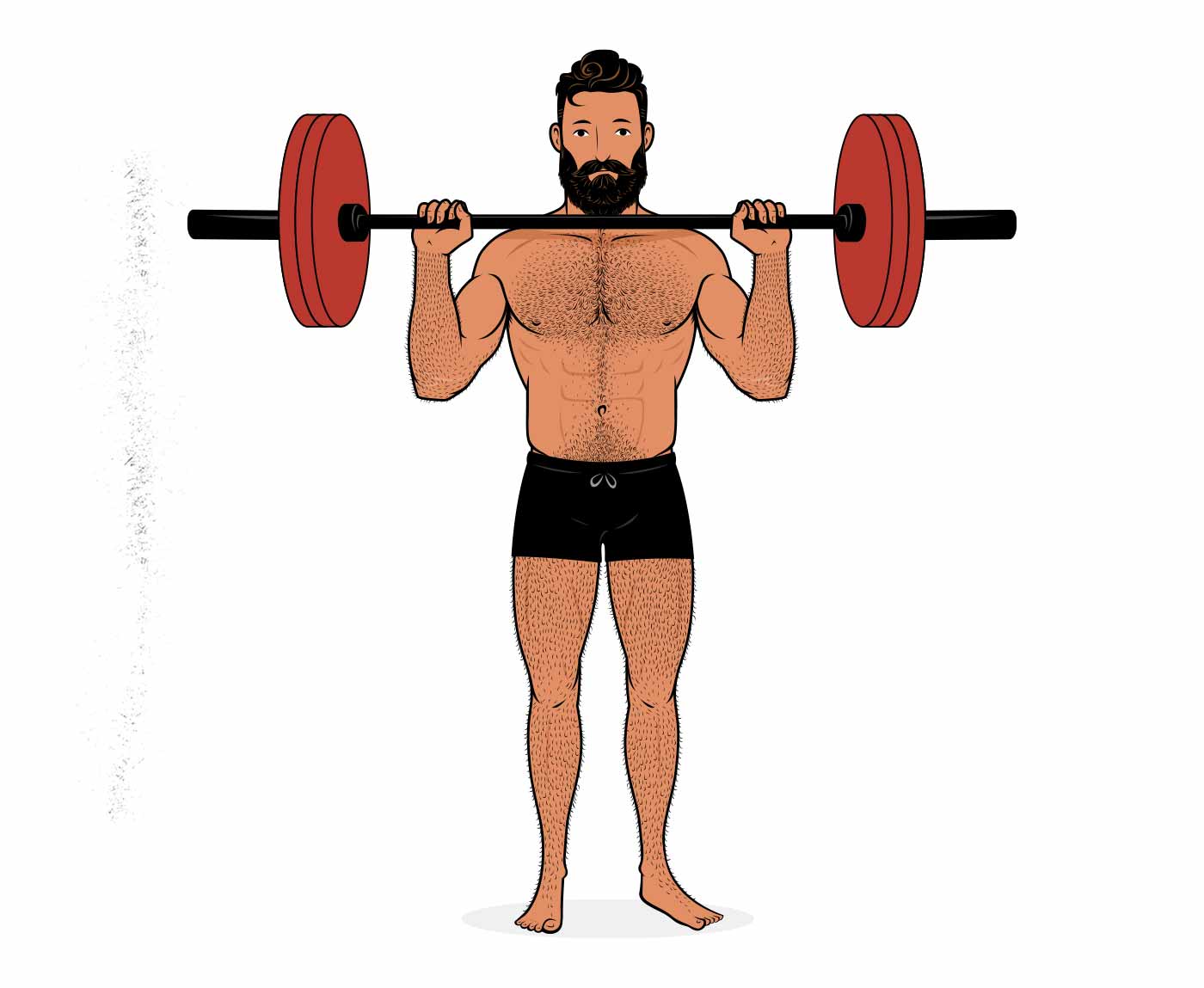
What is the Overhead Press?
The overhead press, also called the military press, is a compound exercise used to develop upper-body strength, focusing on the shoulders. It’s popular in both strength training and bodybuilding routines, and it’s considered one of the main barbell lifts, along with the squat, bench press, deadlift, chin-up, and barbell row.
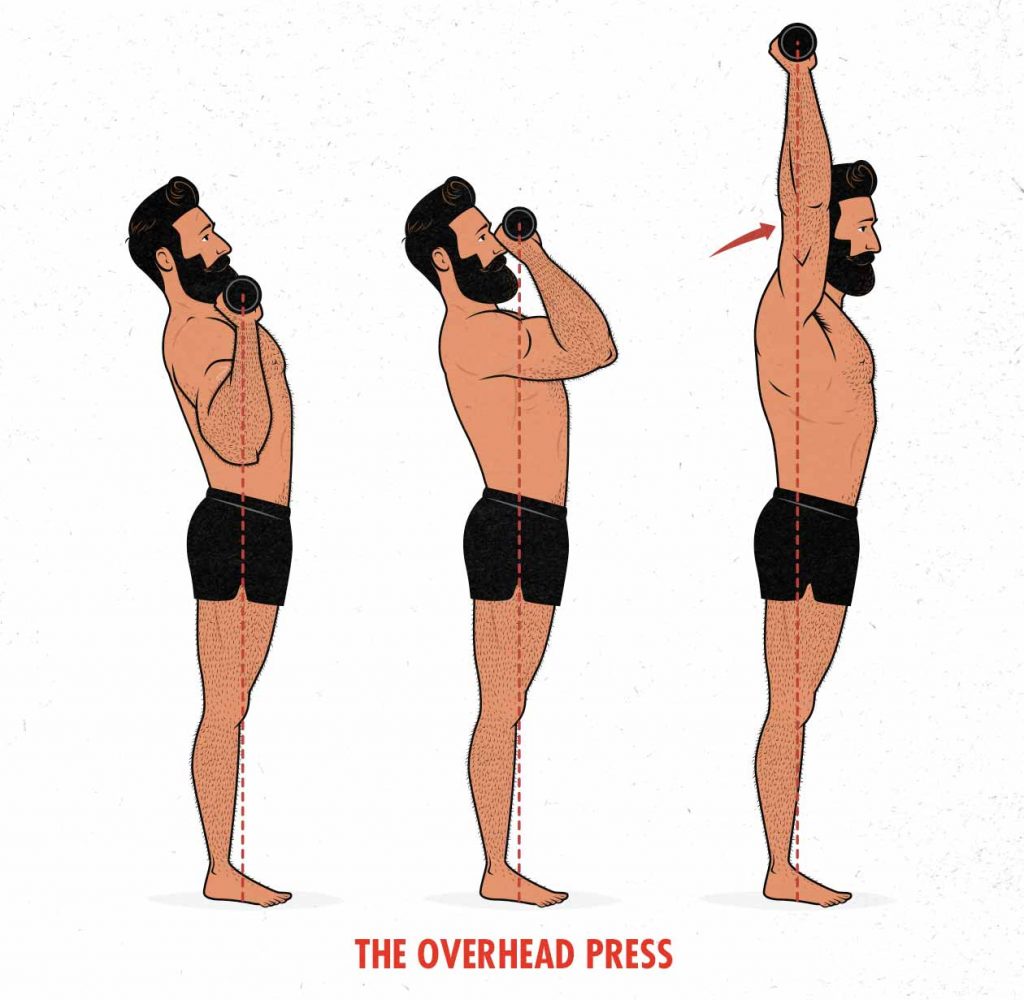
The overhead press can be done with dumbbells or kettlebells, but using a barbell makes the lift sturdier, allowing you to lift more weight and engage more overall muscle mass. And it can be done seated, but standing will engage more muscle mass.
What Muscles Does the Overhead Press Work?
The overhead press is big compound lift that’s great for working our shoulders. It works our front delts and side delts, making our shoulders both bigger and broader. But many different muscles are worked hard enough to stimulate muscle growth, including our traps, abs, and triceps.
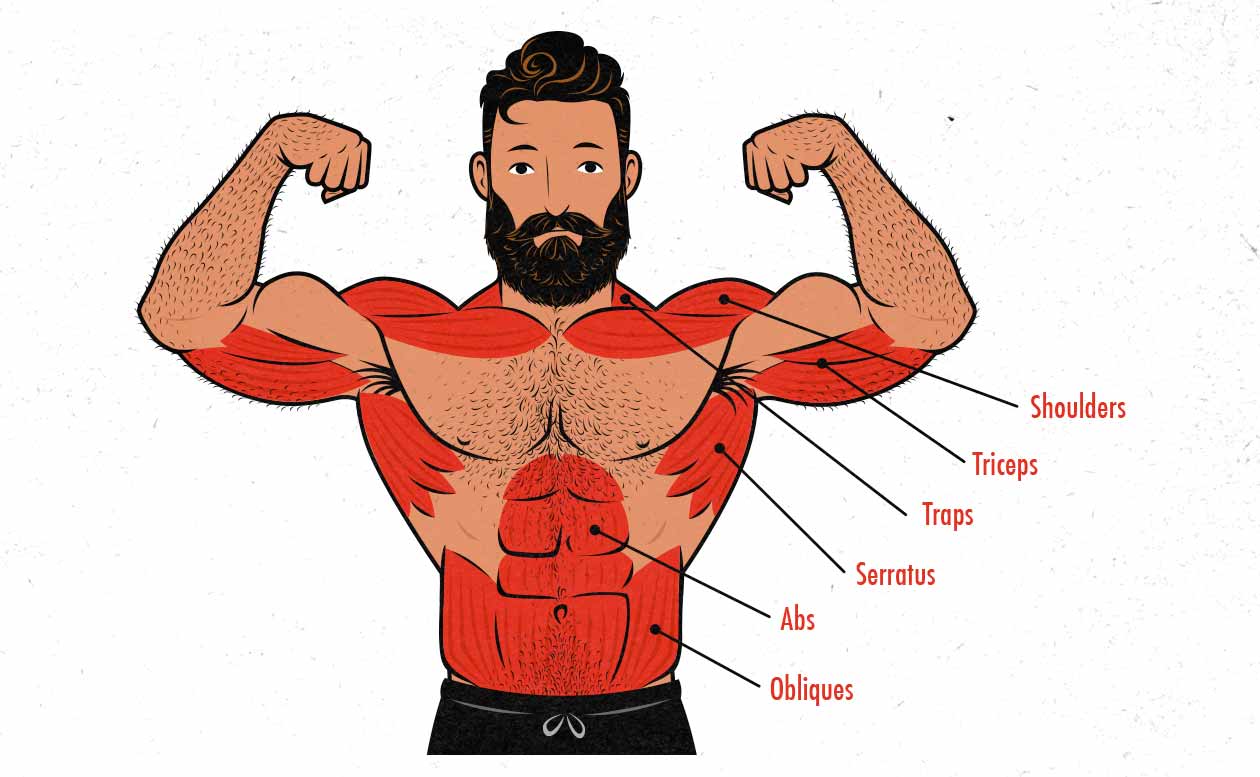
Starting with our shoulders, the overhead press is one of the only lifts that engages both our front delts, giving us bigger shoulders, and our side delts, giving us broader shoulders.
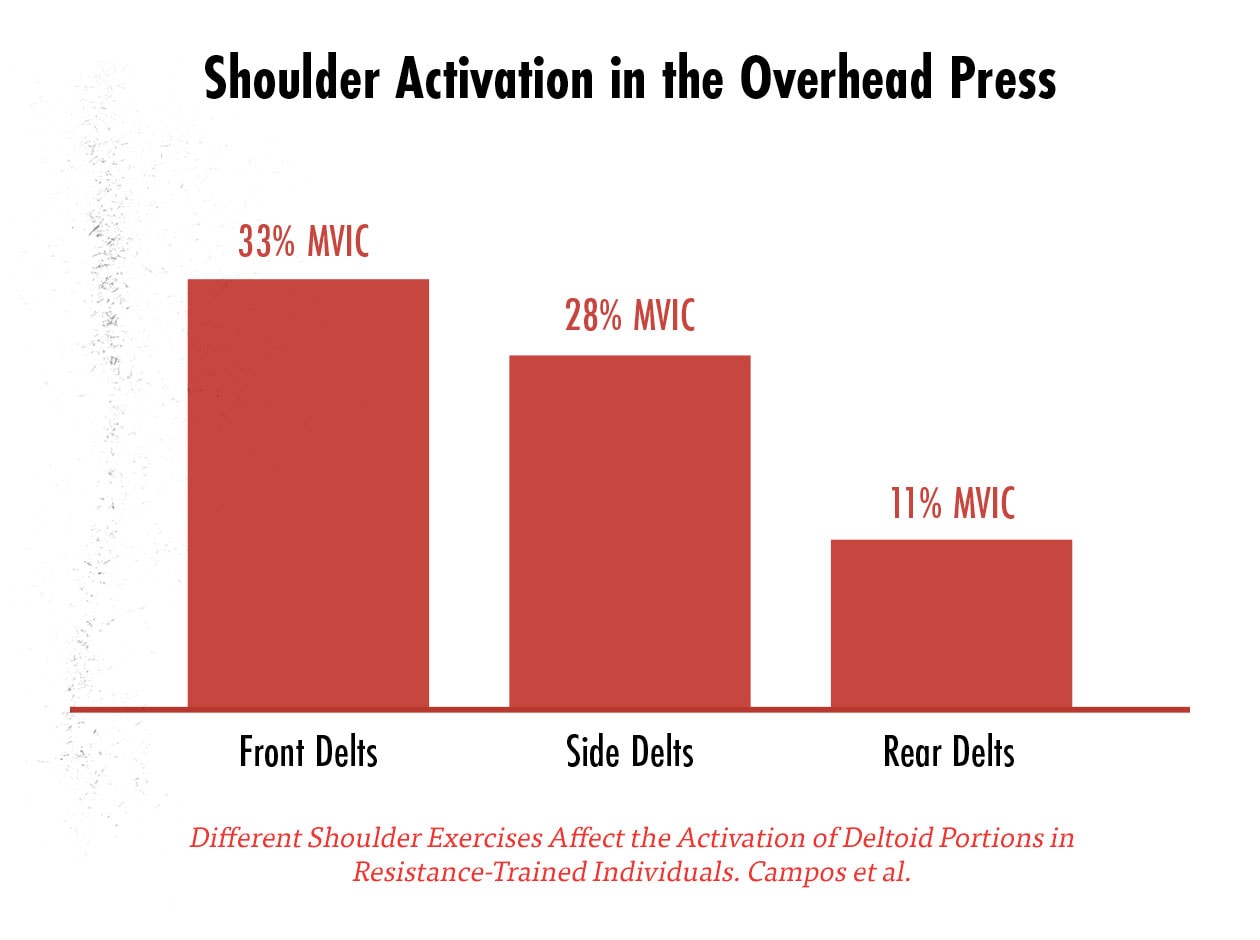
And these muscles tend to be our limiting factors, meaning that they’re almost always worked hard enough to stimulate a maximal amount of muscle growth. This makes it one of the best lifts for improving our aesthetics, and the best main exercise in any shoulder workout.
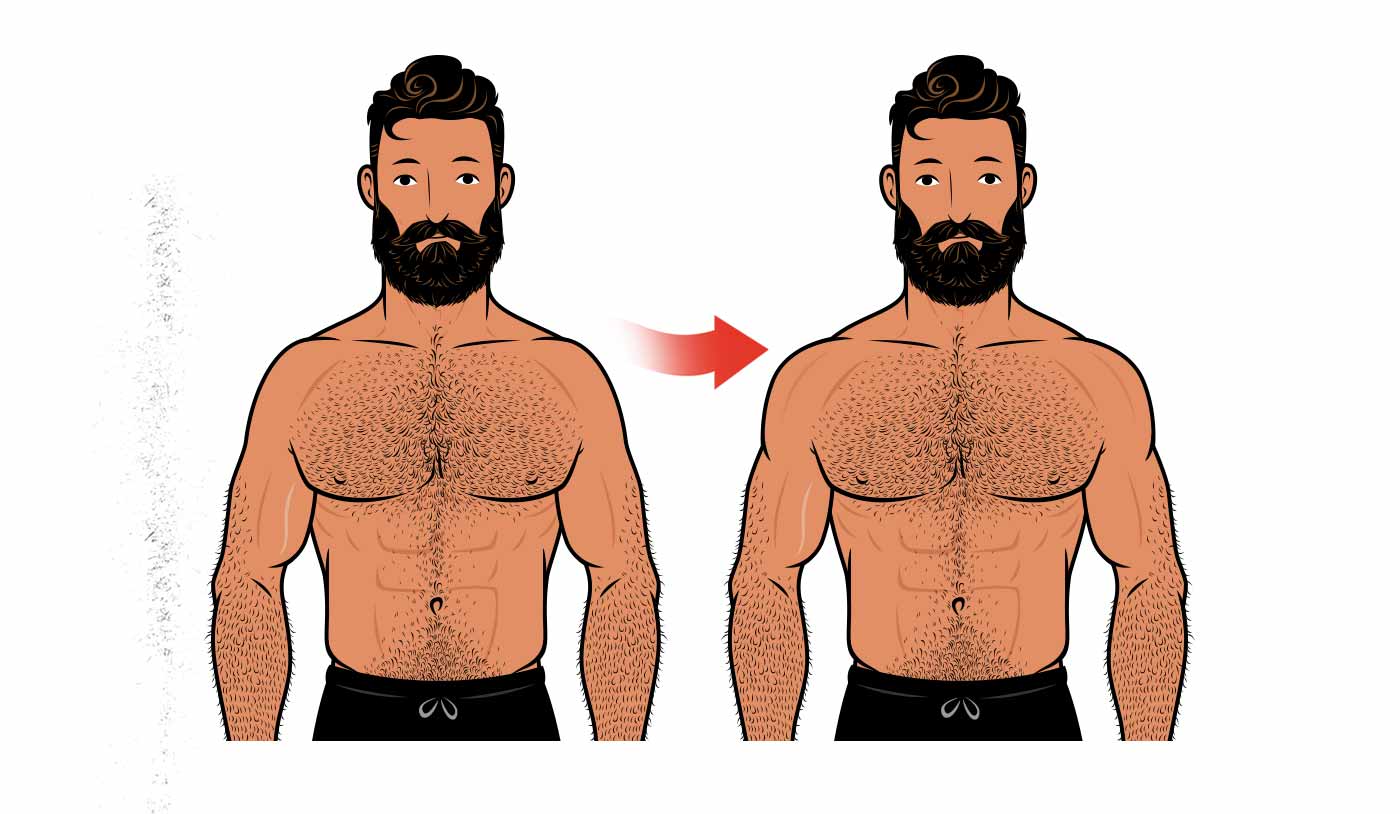
The overhead press is also great at working the medial and lateral heads of our triceps. However, note that the overhead press doesn’t work the long head of our triceps (full explanation). If you want to build bigger triceps, you’ll want to include triceps isolation lifts, such as skull crushers, overhead extensions, or even pullovers. That way you can bulk up all three heads of your triceps.
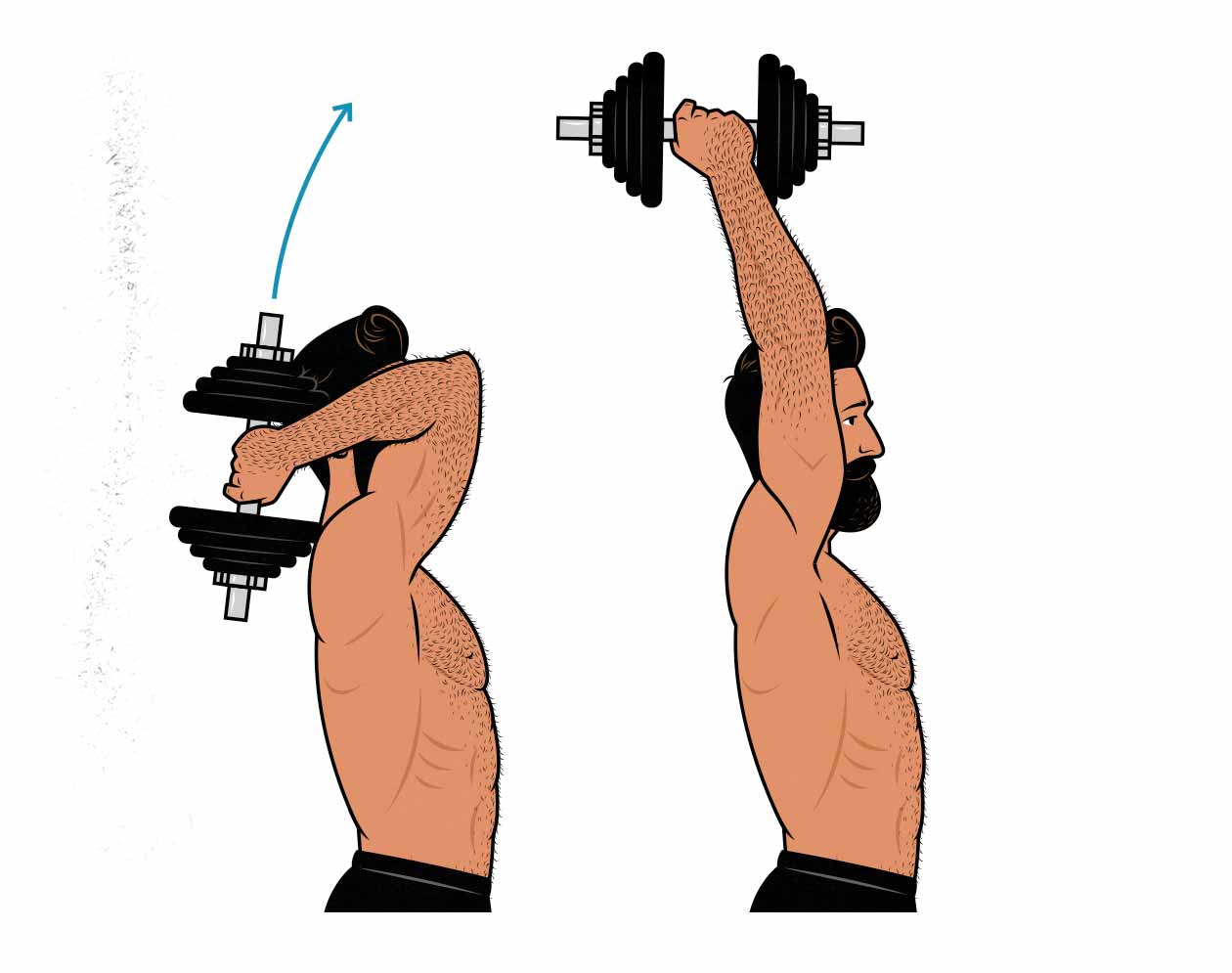
A lesser-known fact is that the overhead press is also great for building bigger traps, which assist our shoulders when lifting weights overhead. This removes the need for doing shrugs as an isolation lift. But again, note that the overhead press won’t give you full neck development. If you want to build a bigger neck, it helps to include some neck curls and extensions, too.
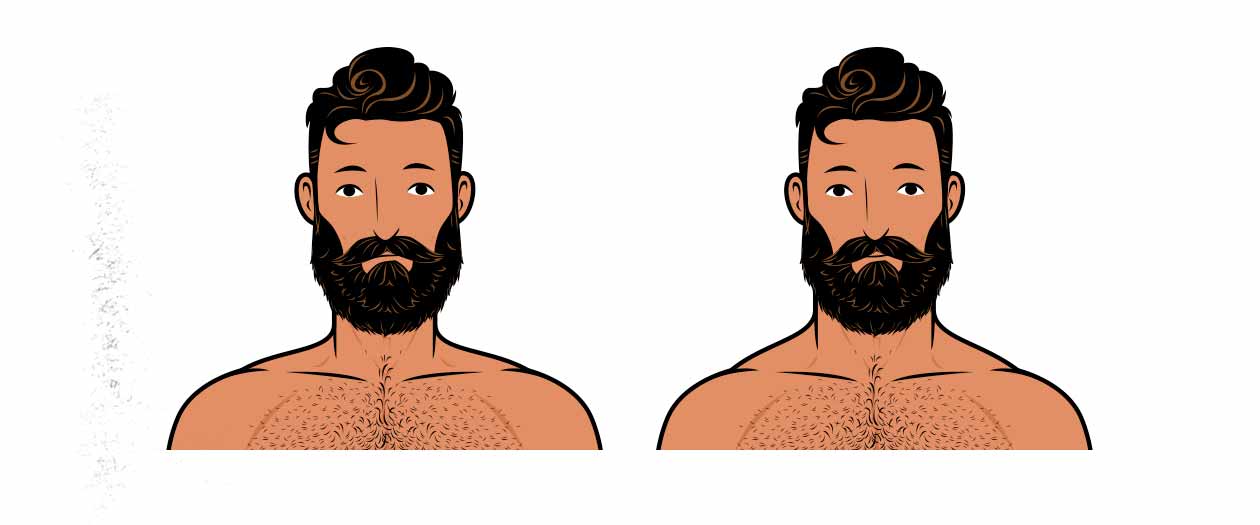
The overhead press does work the upper chest, but it doesn’t always do a great job of it. For instance, the flat barbell bench press works our upper chest twice as hard (study). To build a bigger upper chest, then, you may want to include some incline or close-grip bench pressing.
If you do the press while standing, it’s good at working your abs and obliques. It’s not quite as good as the chin-up, but it does a much better job of stimulating your abs than the bench press, squat, and deadlift (study). In fact, if you’re doing both chin-ups and overhead presses, your core will get a fairly solid workout, and you may not need ab isolation exercises.
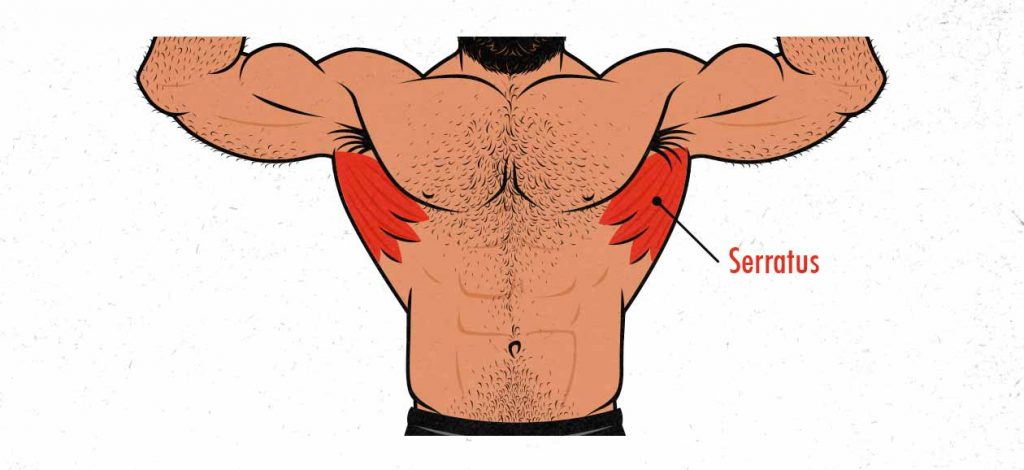
Finally, pressing overhead also works several important postural muscles, such as our serratus anterior and external rotator muscles (supraspinatus, infraspinatus, and teres minor). That’s one of the reasons you’ll often see powerlifters using the overhead press as a way to keep their shoulders strong, tough, and pain-free.
How to Do the Overhead Press
The overhead press starts from a standing position with the weight on your upper chest (or just above). Keep your chest high, brace your core, and press the weight overhead.
Here’s Marco teaching the overhead press:
It’s not quite as simple as it looks. At the start of the lift, you need to tuck your chin, and you may need to bend back slightly at the hips, allowing the barbell to clear your chin and nose. Then, once the barbell is past your forehead, you can bring your body and your head back underneath it, like so:
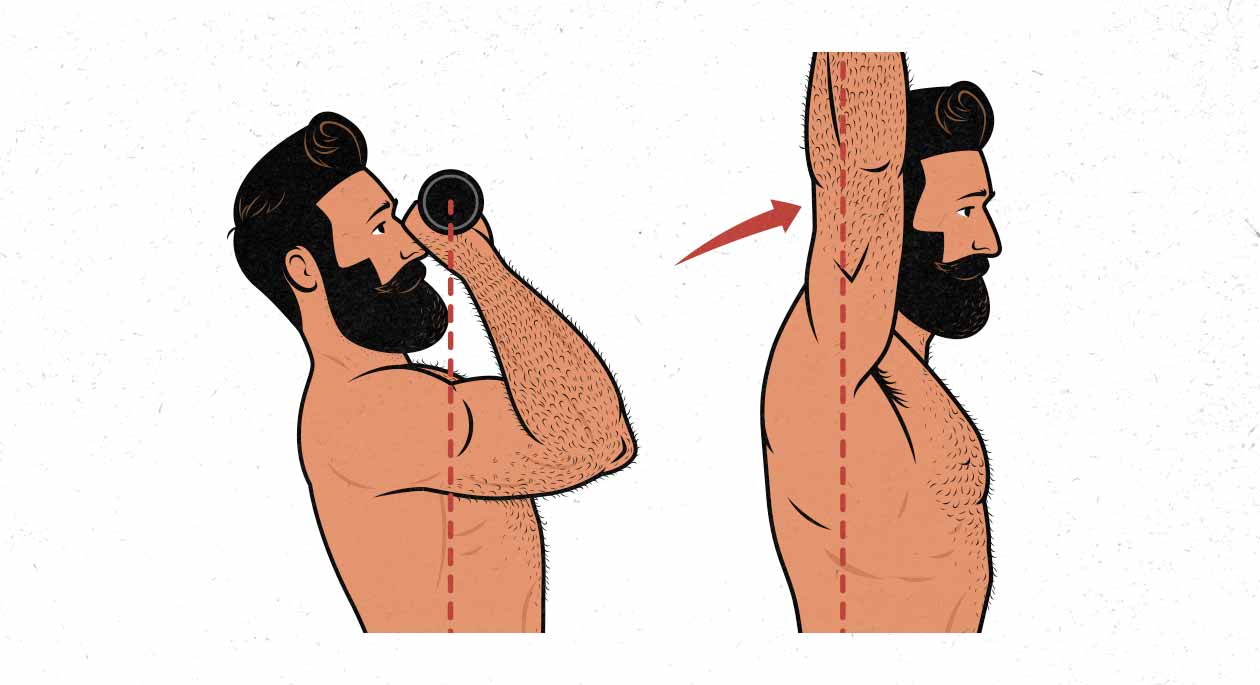
Here are some cues to think of as you overhead press. Don’t think of all of them at once. It’s often better to focus on just one thing at a time. Pick the one that seems like it will help the most.
- Lock your ribs down. Take a deep breath and brace your abs hard.
- Clench your glutes hard. And bend at the hips, not the lower back.
- Puff up your chest. You do this by clenching your upper back muscles.
- Lat shelf. Raise your elbows and flex your lats to create a shelf out of your upper back.
- Put your head through the window. Once you’ve lifted the barbell over your forehead, drive your head through the window.
- Shrug! Shrug the weight up as you press it overhead. It’s a trap exercise, too.
Min-Maxing Your Technique
If we’re trying to build muscle with the overhead press, our main opponent is the extreme moment arm halfway through the lift, as we’re trying to navigate the barbell over our foreheads, right here:
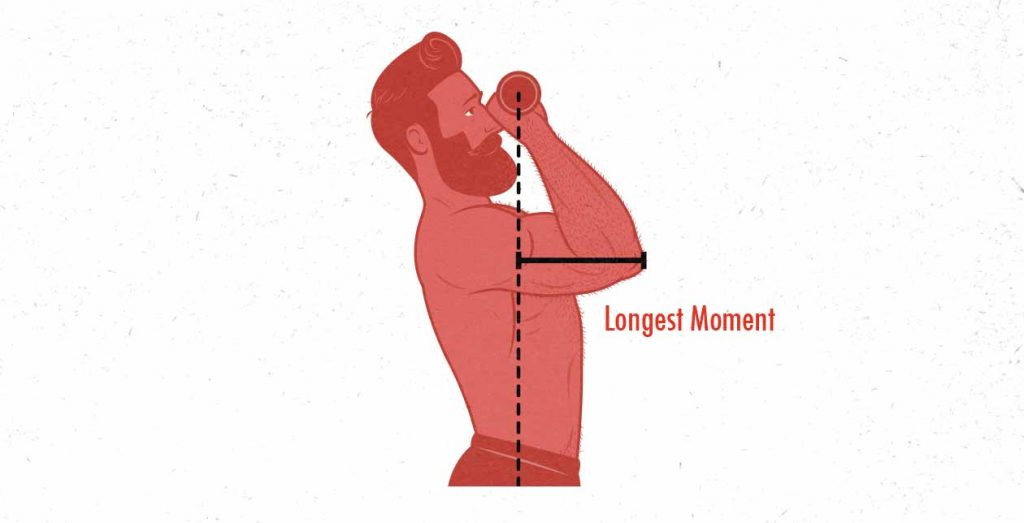
That’s the pesky spot in the lift where our shoulders are most likely to give out. Now, every lift has a sticking point. And obviously, you’ve got to fail somewhere. The thing is, this moment arm is so extreme that by the time we’re failing our set, our shoulders might not even be tired yet. If you’ve ever failed a rep out of the blue, this is why. It’s a troublesome strength curve.
Fortunately, there’s a pretty solid way to improve the strength curve: lift explosively. As soon as your rep starts, heave the barbell off your chest with all the might you can muster. The more momentum the bar has when it reaches that sticking point, the better. Remember, all you need to do is clear your forehead, at which point you can bring your torso under the bar and get rid of that pesky moment arm. And besides, even if you continue to fail at the sticking point, your shoulders will have been working hard to accelerate the bar up until that point, improving your growth stimulus. Lifting explosively almost completely fixes the strength curve.
There are a couple of different ways to do an overhead press. There’s the classic “strict” press, sometimes called the military press, where you start with the barbell on your chest and muscle it up with pure shoulder strength. Momentum is discouraged. Then there’s the push press, where you drive into the barbell with both your legs and your shoulders. Each has its pros and cons.
The Argument for the Strict Press
The main argument for doing a strict overhead press is that it keeps the lift good for bulking up the shoulders. People worry that if we add in leg drive, we make the lift easier on our shoulders, turning it into a lower-body exercise. That’s not quite right.
After the bar leaves the shoulders, the lift becomes almost identical to the press, and the arms are of course always pushing with all the upward force they can muster.
Glenn Pendlay, the legendary strength coach
With both the overhead press and the push press, the shoulders should be firing maximally in an attempt to accelerate the bar upwards. The push press doesn’t take away from the shoulders, it just adds in some leg drive.
If that leg drive allows us to lift more weight for more reps, if anything, it will improve shoulder growth.
Still, most people should start with a regular overhead press. Yes, try to accelerate the bar as you lift it. Give it the momentum it needs to clear the sticking point. But generate that momentum from your shoulders, not your hips and legs. It’s a complicated lift, and the fewer moving pieces there are, the easier it will be to master the movement. We don’t want you to heave the weight up into your nose, shift all the strain to your lower back, or ingrain poor technique. Start simple, advance from there.
The next consideration is your anthropometry. In an ideal world, the weight would start on your upper chest. However, if you have long forearms relative to your upper arms, it might hover a few inches above your chest, like so:
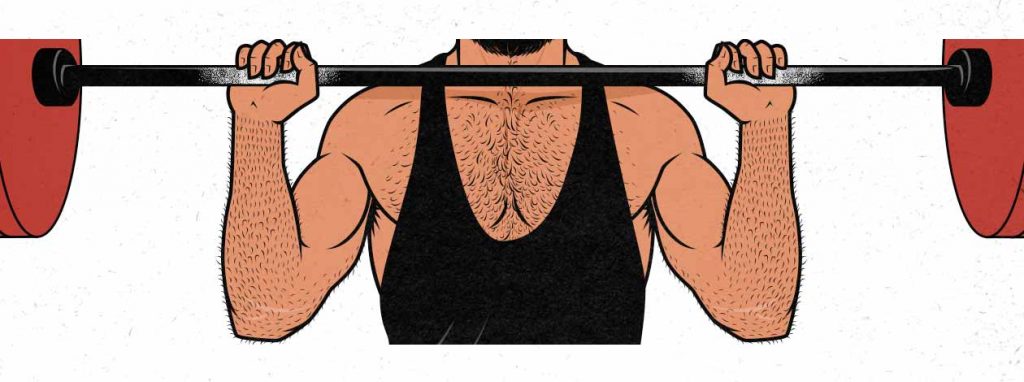
This presents a problem. If the bar is hovering over your shoulders, the force from your leg drive can’t be transferred properly. All you’d be doing is jarring your shoulders. For the leg drive to work properly, you need the barbell to have a solid connection with your torso.
Now, Olympic lifters have found a solution to this problem. They hold the barbell further back in their hands and cock their wrists back, worsening their grip but allowing for proper leg drive. For their purposes, that makes sense. For our purposes, not so much. We’d indeed be turning the overhead press into a lower-body power movement.
Finally, there’s no need to fix a lift that isn’t broken. If you’re gaining strength at the overhead press, your shoulders and traps get at least a little bit sore afterwards, and you don’t have an extreme sticking point, there’s no reason not to stick with the standard overhead press. It’s only once you start to run into problems that you’d want to consider the overhead press.
The Argument for the Push Press
The classic overhead press is a great lift for developing the shoulders, triceps, and even the upper back. However, we can greatly improve the strength curve by making the lift more explosive.
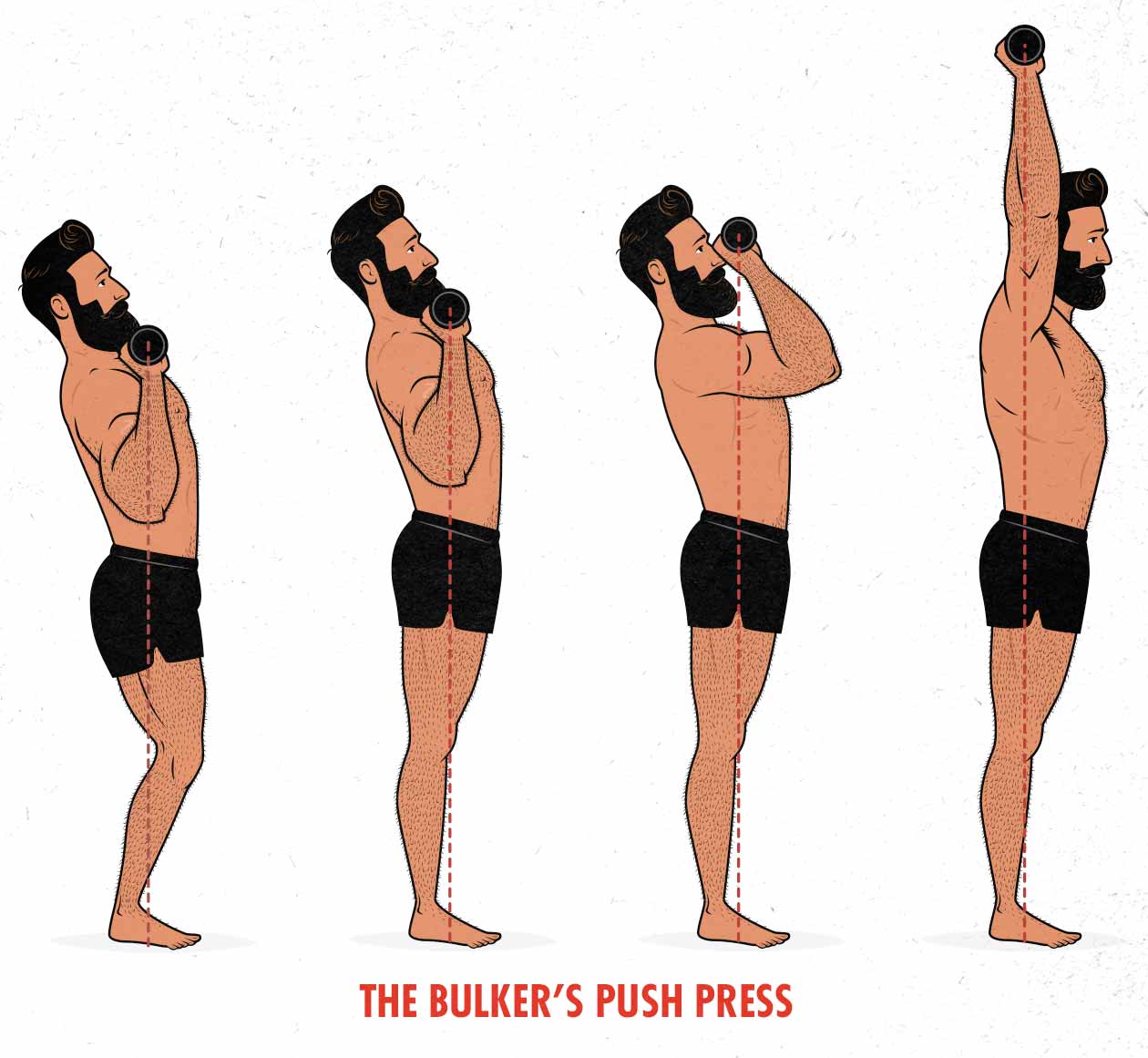
If you use some leg drive to throw the bar up—more like a push press—then you can blast through the sticking point and struggle through the rest of the lift, which is absolutely perfect for building muscle. Plus, you’ll get to use a heavier weight, which will allow you to stimulate a bit of extra muscle growth as you lower the weight back down afterwards.
Now, to be clear, this isn’t quite a “push press.” The push press is a specific move that’s used in Olympic weightlifting. We’re just trying to gain muscle and general strength. If I recall correctly, Greg Nuckols, MA, refers to this variation as a “cheaty overhead press.”
If you tell people that you’re doing an overhead press, they’ll accuse you of cheating. If you tell people that you’re doing a push press, they’ll cringe. But if you tell people that this is the best variation for gaining size and strength in your shoulders, they’ll love you.
If adding some leg drive into your overhead pressing allows you to (safely) clear your sticking point, go for it. The extra weight and reps will improve muscle growth.
How to Increase Your Overhead Press
When you first start doing the overhead press, the best way to get stronger is to practice. The more you can practice your technique, the better you’ll get at activating your muscles and the better leverage you’ll develop. A good place to start is to do the overhead press 2–3 times per week.
When your technique is solid, the best way to keep gaining strength is to bulk up the relevant muscles. To overhead press more weight, you’ll need bigger shoulders, bigger traps, and bigger triceps. There are three approaches we can take to make those muscles bigger, in order of importance:
- Overhead press variations: the best way to get stronger at the overhead press is to do variations of the overhead press. We can do the standing barbell overhead press, the standing dumbbell press, the seated overhead press, and so on. All of the muscle we build with these lifts will directly increase our overhead press strength.
- Assistance lifts: after we’ve done our overhead pressing, we can do lifts that work a similar movement pattern. This will give our joints a bit of a break from the repetitive strain, it will help us build more balanced musculature, and most of the muscle we build will help us improve our overhead press.
- Accessory lifts: we can also train our shoulders, triceps, and traps separately, choosing lifts that work them with the best strength curve and that bring them close to failure. For example, the overhead triceps extension will work our triceps much better than the overhead press, making it a good lift for that particular muscle. The catch is that only some of the strength we gain will translate to our overhead press. After all, an overhead triceps extension does nothing for our shoulders or traps, so it won’t always help us overhead press more weight.
Remember that you don’t need to do all of these exercises every time you do the overhead press. You can spread them out over the week. Maybe you do overhead presses and triceps extensions on Monday, push-ups and lateral raises on Wednesday, and the incline bench press on Friday. That way, you’re working the relevant muscles 3 times per week and adding up enough weekly sets to maximize your muscle growth.
The trick when choosing assistance and accessory lifts, though, is to choose ones that help you strengthen the muscles that are limiting your performance on the overhead press. For example, if your triceps are a limiting factor, triceps extensions will increase your overhead press. But if it’s your shoulders limiting your performance, then they won’t. You’d need a shoulder exercise instead. So let’s go over the different exercises so that you can pick the ones that will help you the most.
The Best Overhead Press Variations
The One-Arm Shoulder Press
One-armed presses are a great assistance lift. The movement pattern is nearly identical, making them great for bulking up your shoulders and traps. However, they also come along with some nifty benefits:
- They reduce spinal loading, making them less fatiguing. After all, your spine will only need to support a single dumbbell at a time. This allows you to sneak in more shoulder work without harming your recovery.
- They’re great for your obliques, given that your obliques will need to work 68% harder to balance the asymmetrical weight (study).
- They emphasize your shoulders/traps over your triceps. Since there’s no barbell keeping the weights from falling off to the sides, your shoulders/traps need to keep the weight centred. It’s not necessarily a good thing that your triceps involvement is minimized, but it makes dumbbell presses absolutely fantastic for bulking up your shoulder girdle.
The downside to one-armed shoulder presses is that they’re too similar to overhead presses. With a lift like a deadlift, it makes sense to use similar but lighter variations to make your workout routine less tiring. But with an overhead press, unless you’re insanely strong, you probably aren’t going to have fatigue issues. It often makes sense to choose another heavy lift.
The Best Assistance Lifts
When you’re choosing assistance lifts for the overhead press, you want to think about which muscles limit you. Then think of which lifts strengthen those muscles. Also, think of which movements feel best on your joints, give you the best muscle pump, and give you the most soreness in the following days. Those are good signs that the lift is helping you build muscle.
For example, most people are limited on the overhead press by the strength of their front delts. The incline bench press and close-grip bench press are great for building bigger front delts. They make great defaults. But if they hurt your shoulder joints, maybe the push-up or landmine press is a better choice.
The Incline Bench Press
The incline bench press is another good lift for working our upper chests and front delts. A shallower incline emphasizes the upper chest, whereas a steeper incline bulks up the front delts. So if your goal is to grow your shoulders, you’ll want to set the bench up at a steeper angle. A 30–45° angle usually works well.
However, note that the close-grip bench press works these same muscles. And it has a deeper range of motion, working your shoulders under a deeper stretch. There’s probably still value in alternating between the close-grip and incline bench press, but I’d guess that the close-grip bench press is the better lift.
The Close-Grip Bench Press
As we covered in our article on strength curves, our muscles grow best if we can load them fairly heavily at longer muscle lengths. One of the pitfalls of the overhead press, then, is that it’s too easy at the beginning of the range of motion, and so it doesn’t challenge the fronts of our shoulders in a stretched position.
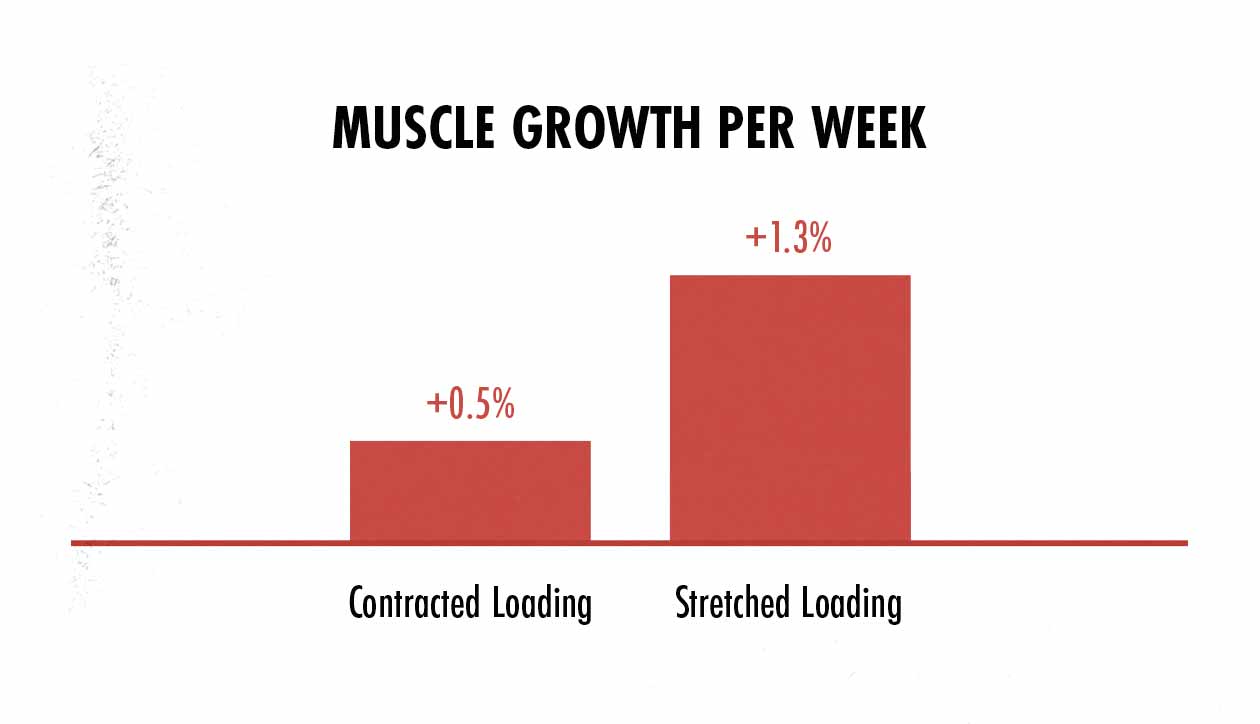
The close-grip bench press is the perfect fix for this. If we use a narrow grip, keep our arch modest, and bring the barbell down lower on our torsos (just below the sternum, usually), then we not only get quite a good stretch on our front delts and upper chest, we also challenge them in that stretched position:
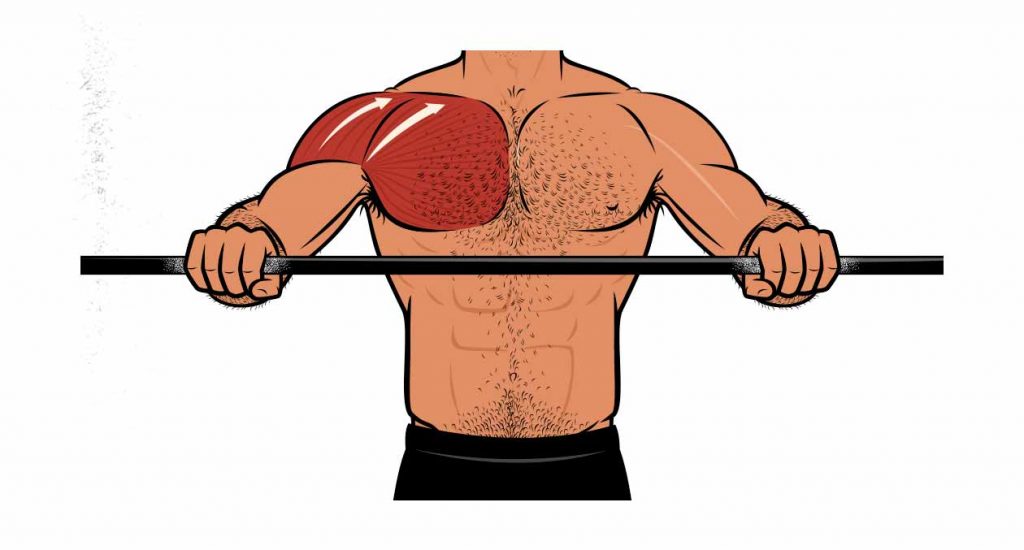
Now, keep in mind that the overhead press’s main advantage is that it works our entire shoulder girdle, not just our front delts. That’s not true of the close-grip bench press. The close-grip bench press mainly works our front delts, upper chest, and, to a lesser extent, our triceps. But if you’re having trouble bulking up your front delts and upper chest, the close-grip bench press is often even better than the overhead press.
The Push-Up
The push-up is great for your chest, shoulders, and triceps. Which muscles it emphasizes is going to depend on your anatomy and your technique.
- Torso angle: deep “deficit” push-ups—raising your hands with handles or weight plates while still bringing your chest all the way down to the floor—tend to emphasize your chest, whereas doing decline push-ups will tend to emphasize your shoulders. (I recommend defaulting to deficit push-ups so that you involve more muscle mass through a larger range of motion.)
- Grip width: wide-gripped push-ups will emphasize your chest, whereas narrow “diamond” push-ups will tend to emphasize the triceps, shoulders, and serratus. (I recommend defaulting to standard-grip push-ups so that you use more overall muscle mass.)
What makes push-ups a great assistance lift for the overhead press is that you’ll probably use a standard grip, which will emphasize your shoulders and upper chest. Furthermore, just like with the overhead press, your shoulder blades won’t be pinned down, working your serratus muscles.
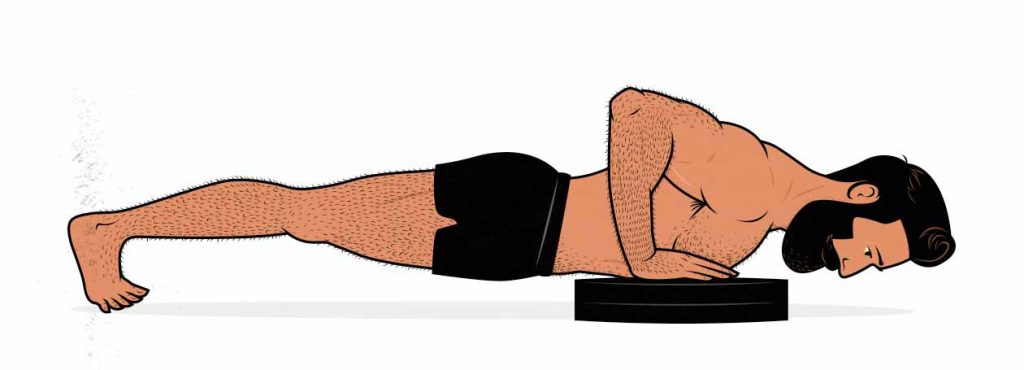
As a result, even though the push-up is horizontal, it’s one of the best assistance exercises for the overhead press. And let’s not forget, push-ups are a great opportunity for us to sneak in some extra chest growth.
The Landmine Press
These are a great lift for bulking up your shoulders and upper chest while letting your shoulder blades roam wild. This makes them a great assistance lift for guys who are looking for more shoulder stability and strength. (You’ll need special equipment for these.)
The Upright Row
Upright rows are a great lift for improving your aesthetics. The limiting factor is often your side delts or traps, and so they tend to get the best growth stimulus, but upright rows also work your forearms, elbow flexors (such as your biceps), and rear delts. It’s a great lift for building stronger, broader shoulders. However, it’s also finicky and surprisingly controversial.
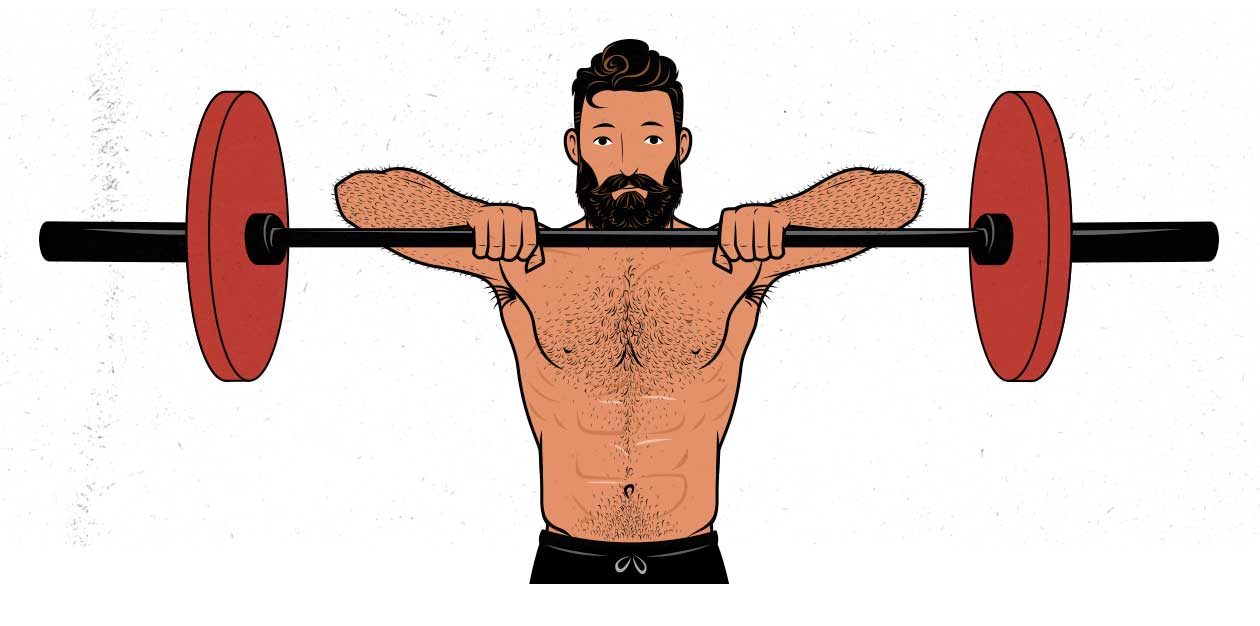
Upright rows are known for causing inflammation in our shoulder joints (shoulder impingement), especially when we try to force a technique that doesn’t feel natural. However, these issues rarely ambush us out of nowhere. If we notice that upright rows make our shoulders cranky, we can either adjust our technique or stop doing them, preventing an injury from ever arising.
The good news is that our bodies are quite good at telling us when something is aggravating them. If upright rows don’t hurt your shoulders, then there’s no reason to think they’re doing any damage. Also, keep in mind that our bodies adapt by growing both stronger and tougher. If we can learn to do upright rows in a way that feels good on our shoulder joints, we can make our shoulder joints more robust.
And, of course, if no matter how you do them, you can’t get upright rows to feel good—stop doing them. Pick a different exercise. Lateral raises tend to be the better lift for people with cranky shoulders.
Accessory Lifts
With your accessory lifts, you want to choose lifts ideal for the various muscles involved in the overhead press. There are two approaches you can take.
- Focus on strength: the first approach is to think of which muscles limit your performance on the overhead press. These muscles are already being stimulated quite well, given that they’re your limiting factor when overhead pressing, but by giving them extra attention, you might be able to speed up their growth. And any growth in those muscles will directly improve your overhead press strength.
- Focus on balance: the second approach is to bring up the muscles that aren’t being worked by the overhead press. For example, the triceps aren’t worked very well by the overhead press, so this is a great opportunity to give them some love. But it won’t do much to increase your overhead press.
If you’re training for maximal strength, you’ll probably want to spend plenty of time training your front delts. But if you’re doing the overhead press and an assistance lift (such as an incline press), and you’re training the bench press as another main lift, then that’s probably enough. Your front delts will already be growing at full speed.
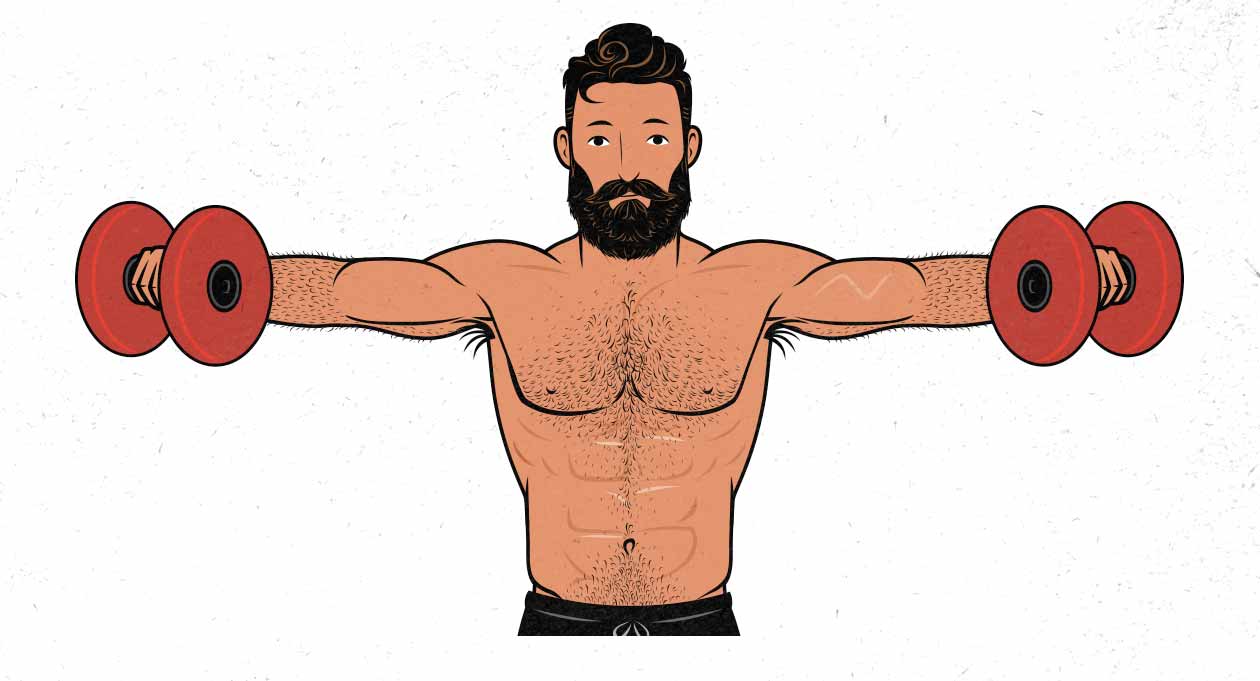
As a default, I’d recommend building a balanced physique, and this list of accessory lifts is designed to help you do that. We’re bringing up the side delts, which probably aren’t getting enough love. We’re training the triceps, which aren’t worked very hard by compound lifts. That’s what we want out of our accessory lifts.
- Lateral Raises: these are among the most popular exercises for building broader shoulders, yet they’re still underrated. Not only are they absolutely incredible for bulking up your side delts (which are often underdeveloped), but they’re also great for bulking up your traps. This makes lateral raises a perfect accessory lift for the overhead press.
- Overhead Extensions: pressing movements don’t fully train our triceps, failing to engage the long heads. That’s where triceps extensions come in. And just like skull crushers pair great with the bench press to round out your triceps development, overhead extensions pair well with the overhead press.
- Pullovers: these are another great lift for bulking up the long head of your triceps, but it allows you to work your lats and your chest simultaneously.
- Skullcrusher pullovers: if you want to add even more triceps emphasis to your pullovers, you can add in a skull crusher movement to finish the lift. That’s going to give the short heads of your triceps a chance to contribute as well, making it a good combo accessory lift for both your bench press and overhead press.
How Much Should You Be Able to Press?
I surveyed 580 of our readers, asking them how long they’d been lifting and how much they could overhead press (survey results).
- Most beginners start at 45–85 pounds for sets of 6–12 repetitions. Almost nobody can press 135 pounds within their first year.
- After a year of lifting weights, 1 in 10 guys can press 135 pounds for at least one repetition. Most guys are doing their working sets with 65–105 pounds on the bar.
- After three years of lifting weights, 1 in 4 guys can press 135 pounds. None of the guys we surveyed were able to press 225 pounds.
- After 5 years, 1 in 3 guys can press 135 pounds. That’s where most guys plateau. A 135-pound bench press is better than average, no matter how long you’ve been lifting.
- After 10 years, 2% of guys can press 225 pounds overhead. It’s an impressive feat of strength. Most lifetime lifters never get there.
For more on strength standards, we have an article on how much the average man can lift.
Summary
The overhead press is an incredible lift for improving our general strength and aesthetics. It engages a ton of muscle mass throughout our bodies, and it’s perhaps the single best exercise for building broader shoulders.
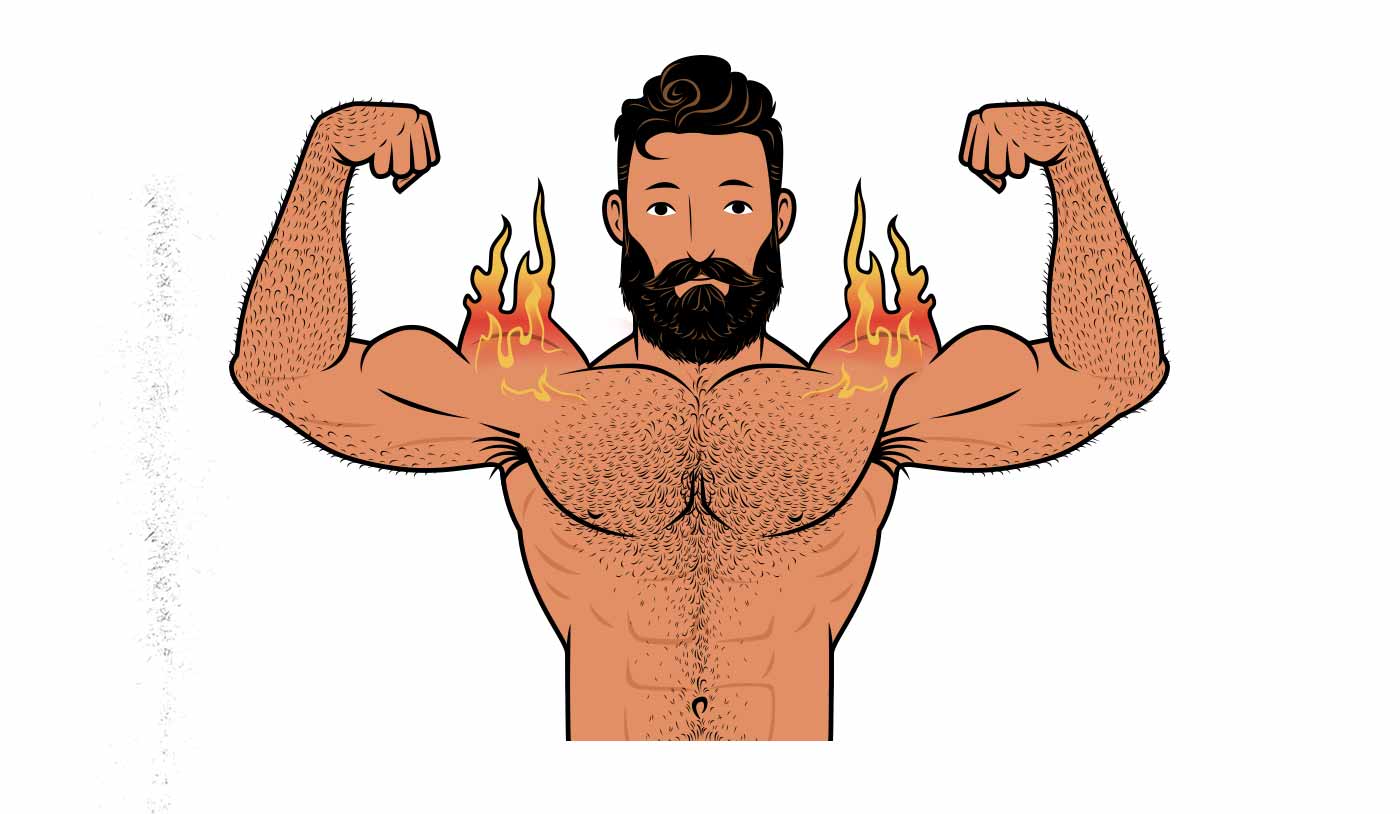
The overhead press’s main problem is its iffy strength curve. It doesn’t challenge our shoulders under a deep stretch, and it has an extreme sticking point when the barbell is around forehead height. This is why it can help to lift explosively, driving into the bar with full force right from the beginning of the range of motion. That makes it harder on our muscles at longer muscle lengths, and it can help us overcome the harsh sticking point. And even then, you’ll need to learn to grind through it. At the end of a challenging set, the reps can be slow.
Aside from spending more time overhead pressing, the best way to increase your strength is to build bigger shoulders. The incline bench press and close-grip bench press are great for that. Plus, both lifts have a better strength curve, addressing the main downside of the overhead press. Or, if you want to take it easier on your shoulder joints, you could use push-ups.
When choosing your accessory exercises, focusing on your front delts is a good way to improve your strength. But they probably don’t need the extra attention, especially if you also do the bench press. I’d recommend focusing on your side delts and triceps instead. Lateral raises are great for your side delts. Skull crushers and overhead extensions are great for your triceps.

If you want a customizable workout program (and full guide) that builds these principles, check out our Outlift Intermediate Bulking Program. If you liked this article, you’d love the full program. Or, if you’re still skinny or skinny-fat, try our Bony to Beastly (men’s) program or Bony to Bombshell (women’s) program.



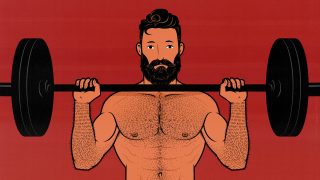
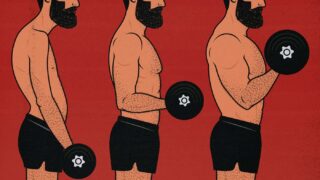
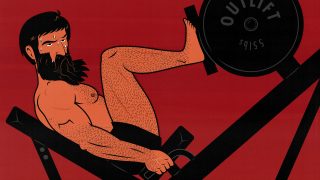

Good stuff, as per usual.
I think one of the tricky things with allowing leg drive in the overhead press is not to get carried away with adding weight to the bar. I started with a weight I could OHP for 11+ reps and over a few months continued adding weight until I was using a weight greater than my OHP 1rm, but could still push press for 5+ reps.
After resetting the weight, I discovered I had actually only added 5lb to my 9 rep OHP. Still, I’m continuing to grow and didn’t injure myself in the process, so no harm done.
Thank you, Jeremy 🙂
Yeah, that’s a great point. Unless form is consistent, pretty much impossible to track progress.
This is another great article.
Not only a page turner, but one I’ll want to reread (sooner rather than later).
Regarding Overhead Press and the Upper Traps, you say:
“…it actively works our traps through a large range of motion”
“Shrug the weight up as you press it overhead”
I’d like to ask two questions, please:
1. On ROM: Does one zone of the ROM work Upper Traps more than rest of ROM?
2. On Shrugging: Does Shrug start when first starting to lift at bottom?
Is Shrug maintained throughout entire repetition (on way up and way down)?
Does OHP takes place with shoulders up to ears the whole range of motion?
Thank you very much!
I love this site and I am hoping one day your Outlift (or B2B) program will have a version for those of us doing only to the big 5 compound lifts you recommend (that I can adapt to my compound-only body-weight 5-lift training).
Hey Fleischman, thank you!
For your first question, yes, some of the range of motion surely works the traps harder than the rest. I’m not sure which part that is, though. I’d just be guessing.
For your second, with these big compound lifts, you shouldn’t really be thinking about working or flexing specific muscles, just about moving the weight. But your traps will start working right from the beginning. The lift starts with the traps at a longer length, not with them shrugged up. Then, as you press the weight overhead, your traps will contract.
So far all of the research shows advantages to using a wider variety of lifts, combining both bigger compound lifts with smaller isolation lifts. But even when doing only compound lifts, probably better to use a mix of them. It’s easier on your joints, better for building muscle, develops more versatile strength. Even if we make a minimalist program, it would be more than just the five big lifts. You might really like it, though 🙂
Thank you, Shane. The answers are helpful.
Regarding using more than just 5 Big compound lifts, do you mean more “variations of the same lift” (say for horizontal push “narrow-hand-separation push-up” Plus “shoulder-width push-up” instead of only the latter)? Or do you mean more “larger lift variety” (say for horizontal push doing “[tuck planche?] dips” Plus “regular push ups” instead of only the latter)? Or both?
Thank you.
All sorts of variety can be helpful. Grip width is part of that. Don’t just bench with a moderate grip, also include some phases where you bench a bit wider or narrower (provided that it feels good to do so). Same with stance width when squatting and all kinds of other mild variations. But it’s also good to include a mix of entirely different lifts: bench press AND push-ups AND dips instead of just the bench press, you know? That way we’re varying the stress on our joints and connective tissues. Plus, we’re also challenging our muscles in slightly different ways, yielding fuller and more versatile muscle development.
Hello Shane,
Do you agree that OverHead Pressing with a “trap bar” so grip stays neutral (palms facing each other) allows for more natural hand/forearm/elbow positioning vs when using the regular bar?
Thank you.
F
Hey Fleischman, yeah, if you overhead press with a more neutral grip, you might find that it’s easier on your shoulders and elbows. You may find that you’re a bit stronger, too. The same is true with deadlifting with a trap bar or squatting with a safety bar. It’s just a more natural position.
With that said, there are other factors to consider. How wide is the grip? How sturdy does it feel? Does it change how far back you need to lean your torso? And what let’s you press more weight?
But, yeah, using a more neutral grip is great. My favourite way of doing that, though, is to use dumbbells or kettlebells. That way your hands can rotate freely instead of being stuck in a specific angle.
Shane, thank you very much. My overhead press is the “14-Inch-Deficit Elevated-Feet Pike-Push-Up” progression ;-). So I asked that question bc I was wondering if I ought to replicate in my Pike Push-Ups the Standard-Bar Overhead-Press grip (palms facing away from me), since I do not tend to that naturally: I tend to place my palms half way between “neutral” and “facing-away-from-me”, and I guess I’ll continue to do so. Thank you!
I had never heard about this push-press idea, seems really clever. But unfortunately, I will not be trying it out for the time being. I’ve found that I lack mobility (I believe in the lat muscle) to raise my left arm overhead without flaring my rib. I got really worried about it not only because of safety but mainly because of potential imbalances that could occur. So I’m overhead pressing only while seated, with a slight angle to allow my left shoulder to remain in a healthy position. I believe that this activates less of the mid-delts, so I should probably work on my mobility more actively. Do you have any tips on this?
I don’t know how common it is to have those imbalances in mobility, is addressing those issues a part of some of you guys’ program?
Yeah, it’s common for people to lack the mobility to do the overhead press. That’s okay. You can develop it over time as you strengthen that area. That’s something we go into in our Bony to Beastly program, yeah. We assume that many people don’t have the mobility for the main movements so we start with earlier progressions and work our way there.
The seated dumbbell overhead press should be okay for your side delts. I wouldn’t worry too much about that. But the lateral raise is the best side delt exercise, they don’t require much mobility, and they’re a breeze to do, so feel free to add those in 🙂
Hi there!
I appreciate this article. The Overhead Press is one of my favorite exercises. Quick question about how triceps fit into this. In the article you stated that the overhead press is great at working the medial and lateral heads of our triceps, but doesn’t work the long head of our triceps.
Why then would we use an accessory lift (like the overhead extension) that targets the long head to increase the strength of our overhead press if the long head does not contribute? Wouldn’t it be more beneficial for overhead press strength to train the medial and lateral heads of our triceps more so?
Thanks!
Hey Sam, that’s an astute question.
So, the overhead press DOES train the long head of the triceps a little bit, just not very well because the movement at the shoulder joint prevents it from getting fully involved.
With the overhead extension, though, there’s no movement at the shoulder, which means that all three heads of the triceps can be fully trained. As a result, you get some extra triceps growth in your long head with no real downside. It’s possible that the long head will get the best stimulation because it’s being trained at longer muscle lengths, but the other heads will still fire maximally, meaning that they’ll also be limiting factors, and thus get a full growth stimulus.
We also see in some studies, such as this one, that training with a mix of different exercises that only somewhat overlap (such as 2 sets of squats plus 2 sets of leg extensions plus 2 sets of leg press) does a better job of increasing strength than only doing the main compound lift (in this example 6 sets of squats).
But your logic is good. If all you care about is overhead pressing strength, you probably don’t need to worry about training the long head of your triceps. If your triceps are a limiting factor, you could choose accessory lifts like the close-grip bench press, narrower grip push-up, or JM press. If you’re focused on both gaining strength and building muscle, though, then triceps extensions will give you some extra muscle growth with no real downside 🙂
Thank you for the answer Shane,
I see; I didn’t realize that while an Overhead Extension is good at hitting the long-head, it still hits the other two heads just as well. That makes sense that combining the overhead press with an overhead extension would give you the best strength and hypertrophy stimulus.
One follow-up question. If we’re only talking strength, if you wanted to strengthen your overhead press, do you think that doing triceps movements that target the lateral and medial tricep heads more so would help? For example, would training with Triceps Pushdowns help strengthen one’s overhead press, because that exercise targets the lateral head more, or is that such a minor exercise that it would have no real effect overall on strength?
So for improving your strength on the overhead press, the first thing to do is see what your limiting factor is. If your triceps aren’t holding you back, then giving them extra attention won’t improve your overhead press strength at all. In that case, you’d want assistance exercises that help with the muscles that are actually limiting you, such as your front delts.
But if your triceps are your limiting factor, I think you might get a bit more benefit from choosing lifts that more closely mimic the overhead press. A close-grip incline bench press is kind of a triceps exercise, but it will also train your front delts. You’re getting more than one benefit out of it. But purely for your triceps, I’m not sure there’s a downside to triceps extensions.
Of the different variations of triceps extensions, I think all of them will work quite well. Pushdowns, skullcrushers, and overhead extensions all hold the shoulder joint steady, and so all of them will train all three heads of your triceps. The difference is that the further you raise your elbows overhead, the more stretch you put on the long head, and so the better it will grow. But that’s not all that relevant to your overhead press strength, so I suspect that they’d all work similarly well.
If I had to pick a triceps extension variation for your triceps, though, I’d still go overhead. It’s a more similar position to the overhead press. Maybe training your triceps in that position will build strength in a way that’s more relevant to your overhead press. Again, though, I’m just guessing here. (There’s certainly a tradition of powerlifters using this same logic to choose skullcrushers to strengthen their bench press. And adopting that approach is a big part of what helped me bring my bench press up to 3 plates.)
What is they typical press weight for the single arm press? Unless your talking about single arm press of 175! If can do a 70lb single arm does that translate to 70lbs with a kettle bell?
For the overhead press standards, I’m talking about the barbell overhead press. Typically when converting that into dumbbells, you’d be aiming for well less than half of that, given that dumbbell exercises aren’t just one-handed, they’re also harder to stabilize, and we can’t take as much advantage of our triceps strength. When converting from dumbbells to kettlebells, it depends. Sometimes the dynamics of kettlebells make them a little easier or harder to use. With the overhead press, I find that kettlebells make it easier and that I can lift at least as much as I can with dumbbells.
Hey Marco, you better go back to having your Mom buy your clothes. Those pants aren’t doing you any favors. Haven’t you noticed all the girls smiling behind their hands when you’re around?
The time table on the ohp progression is a bit steep.
What do you mean?
Hey Shane, did your newsletter poll generate some real life figures for the OVP as well as it did for the bench press.
Best regards
Sebastian
Hey Sebastian, yep! That’s one of the reasons I wanted to do the poll. I’ll be updating these articles one by one. I have a new article on bench press standards up already. I’ve been up in Canada for my little sister’s wedding, so it’s been taking me a little while. I’ll send the results to the newsletter once I’ve gone through all of them.
Great article! Though the lifting standards seems quite high. Did you receive some figures from the newsletter poll?
Best regards
Sebastian
Thank you! Yeah, so far it looks like squat, bench, deadlift, and overhead press standards are inflated, at least for our audience. However, our readers are amazing at push-ups and chin-ups. I’ll update this article ASAP.
thank you Shane!
I hope you had a great time with your family.
I am looking forward to your results.
Best Regards
Thanks, Sebastian! I’ve got the deadlift done. I can do the overhead press next.
Okay, I’ve updated this article, and I’ve got a new article up with the survey results for the overhead press.